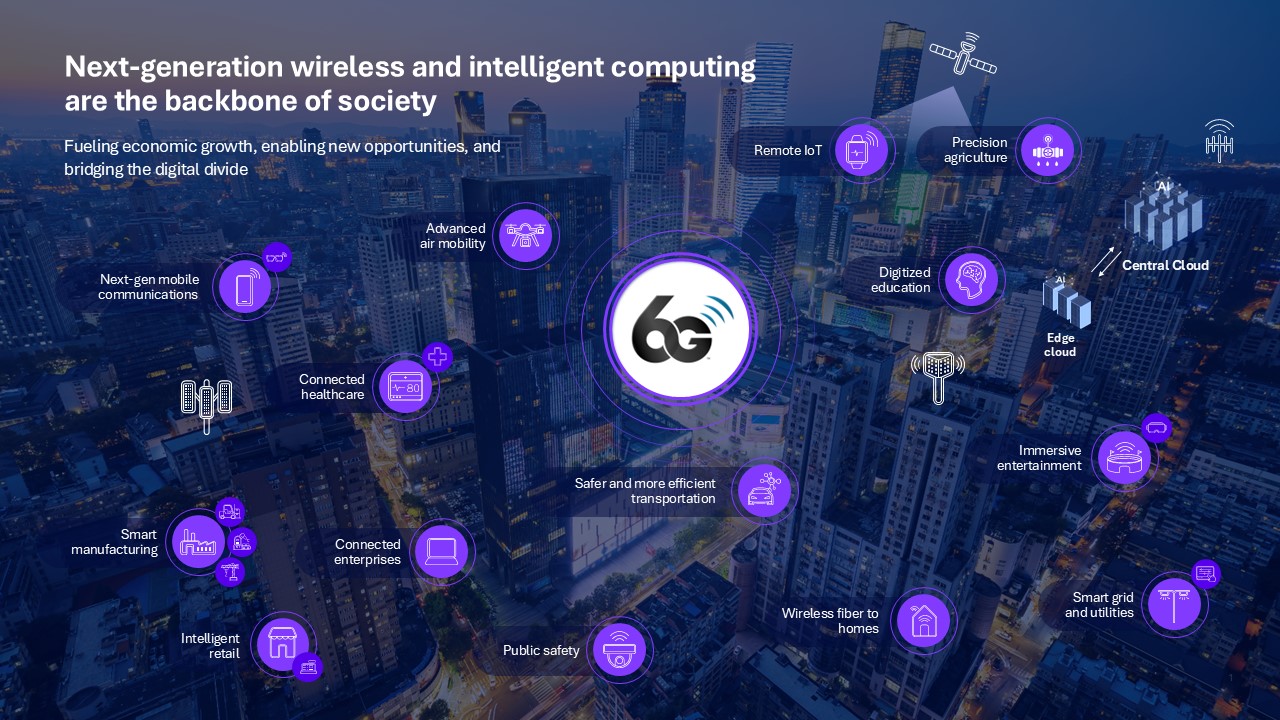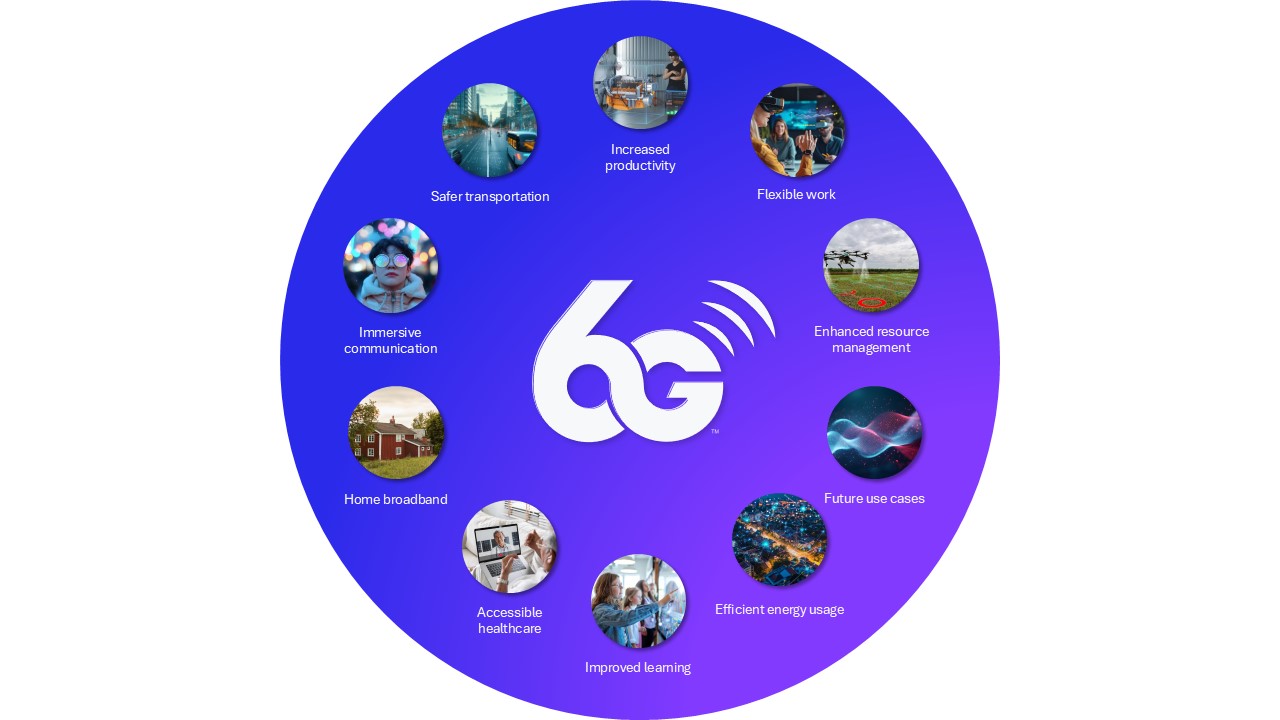Qualcomm’s delegation to the recent 3GPP 6G Workshop discussed use cases, system design priorities and principles
Our vision for 6G is an innovation platform connecting an expansive compute and intelligence fabric for the next decade and beyond. It is a new wireless system that builds on the technical foundation and deployment insights from previous generations. Although the commercialization of 6G networks and devices is not expected until 2030, a new wireless generation is not architected overnight and we have been working on advanced 6G research for many years now. With on-going work in radio technology, system architecture and core networks and protocols, we are now approaching a crucial milestone: the official beginning of the global technology standardization effort by 3GPP in June 2025.
3GPP held a 6G workshop from March 10–11 to start industry discussions and to align on the focus of the Release 20 6G Study Item. As the head of 3GPP standardization at Qualcomm Technologies, I am excited about the challenging work and industry-wide collaborations ahead. For the rest of this blog post, let me highlight the key discussions at the 6G workshop.
Global 6G technology standardization is about to get started. At the recent 3GPP 6G Workshop, mobile ecosystem leaders gathered to discuss the focus of the upcoming 6G study. This is an important moment in time that sets the stage for the global 6G standardization effort, enabling commercialization around 2030.

Highlights from the 6G workshop
The two-day 3GPP 6G workshop took place in Incheon, South Korea. As expected, it was widely attended with 1,676 registrations and 748 in-person attendees across all parts of the mobile ecosystem and vertical industries. We saw a total of 219 input contributions, including those from network operators, industry associations, hardware/software vendors, academia, system integrators and technology providers. Unlike previous generations, contributions came from all regions and from a wide range of companies, in addition to traditional cellular vendors and operators.
The 6G workshop focused on various aspects of the upcoming 6G technology standardization, spanning eight sessions over two days. These include two joint plenary sessions, five parallel radio access network (RAN) and system architecture/core network & terminals (SA/CT) working sessions and a concluding summary session at the end of the workshop. To keep the meeting efficient, only one contribution per company per topic was allowed to be submitted and presented. These sessions focused on the vision and priorities for the Release 20 6G Study Item. Here is a quick recap.
Overall vision for next-generation 6G wireless system
The plenary sessions focused on the overarching 6G standardization principles. The goal was to align on 6G’s motivations and goals, along with targeted use cases, to ensure that a global 6G standard can deliver value for the entire mobile ecosystem. In summary, 6G is expected to enable:
– New services and use cases that extend beyond communications, such as integrated sensing, immersive XR, AI-based services and compute.
– Revenue growth that monetizes network capabilities and supports diverse applications across industries, fully realizing the potential of wireless.
– AI and automation that implement an AI-native network system design, improving efficiency in network management and resource allocation.
– Enhanced system efficiency that reduces energy consumption through new system features in network design and AI-driven power management.
– New and efficient spectrum use that improve efficiency in existing lower bands (e.g., FDD), open new spectrum bands and support dynamic sharing.
– Ubiquitous coverage that seamlessly integrates terrestrial and non-terrestrial networks (NTN) to deliver global coverage and resilient services.
– Reduction in total cost of ownership (TCO) that improves CAPEX and OPEX through simplified network operations and improved energy efficiency.
– Enhanced service reliability and customer experience that ensure high-quality service delivery across diverse devices and network conditions.
– Network simplification that reduces architecture complexity and improves system operational efficiency to meet use case requirements.

6G to address lessons learned from 5G
During the 6G workshop discussions, special emphasis was placed on applying lessons learned from 5G deployments to 6G design and standardization. Addressing these challenges as part of the Day 1 priority for 6G can help with the transition and adoption of the new wireless generation in 2030 and beyond. These include:
– Simplified and smoother migration: The transition from 5G NSA to 5G SA was complex, difficult and slow. 6G should focus on a single SA option with multi-RAT spectrum sharing (MRSS) and seamless 5G interworking.
– Reduced architectural complexity: An excessive number of 5G options, features and configurations led to high system complexity, impacting device capabilities and deployment efficiency. 6G should reduce system complexity to enable faster, more efficient adoption.
– Better adoption of key capabilities: Some 5G features (e.g., slicing) experienced slower-than-expected adoption. For 6G, 3GPP should analyze the underlying causes and address them with simplified system design.
– Efficient deployment: There were several issues identified during the 5G rollouts, such as network repository function (NRF) profiles inefficiencies and protocol challenges (e.g., HTTP/2 over TCP). 6G should address these.
– Enhanced network function (NF) design: Further optimization is expected to ensure efficient NF sizing with clear decoupling, while also further exploring stateless architectures.
– Optimized functionality: 6G should focus on a well-dimensioned set of functionalities, minimizing redundant options and excessive configurations to reduce complexity.
6G radio access network design considerations
The first set of parallel sessions was led by the RAN Plenary, focusing on radio technologies that are expected to come with 6G. Below is a summary of the discussions and alignment on how to approach the new 6G RAN design. The 6G radio interface should:
– Be non-backwards compatible from a device perspective to exploit the full potential of a new generation. Some air interface design (e.g., waveform, modulation, channel coding) can be enhanced, building on 5G NR.
– Deliver significant gains to justify a new 6G radio design.
– Be lean and streamlined, to have a dimension-appropriate set of functionalities, minimized adoption of multiple options of the same functionality and limited configurations.
– Target superior coverage from day one.
– Support diverse device types with scalable design based on — for example — bandwidth, data rate, formfactor, energy consumption, etc.
– Enable a harmonized terrestrial network (TN) and non-terrestrial network (NTN) design.
– Support an extensive wireless AI framework, building on 5G Advanced as appropriate. It should have native support for wireless AI lifecycle management and new use cases.
6G core network design considerations
The second set of parallel sessions was led by the 3GPP SA and CT technical Plenaries, focusing on 6G system architecture, security and protocols. As expected, the discussions were dynamic. While no official decisions were made at the 6G workshop, it is generally agreed that the 6G core network should:
– Have a single 6G standalone architecture, with SA mode as a baseline.
– Be designed to cover new 6G requirements regarding AI, connectivity, security, privacy, resiliency with possible reuse of the 5G service-based architecture framework with possible enhancements.
– Support simplification of architecture and streamlining of network function definitions and interactions, interfaces and protocols.
– Investigate new functions based on the service-based architecture to support new 6G services.
– Integrate and interoperate with various access technologies, including fixed wireless access (FWA) and Wi-Fi.
– Have a unified network exposure framework for simplifying the 3GPP-wide exposure framework to foster an API economy of scale.
What’s next?
With the 6G workshop now successfully completed, we are moving toward the official start of the first Working Group 6G Study Item as part of 3GPP Release 20. This Study Item is slated for approval in the June 3GPP Plenary meeting in Prague, Czech Republic. I am incredibly excited about this upcoming work, and I will be sharing more information soon. Stay tuned.
Learn more about the future of wireless technology, visit our new 6G website
Watch our latest wireless technology demonstrations, visit our YouTube playlist
Sign up for our wireless technologies newsletter to stay up to date

